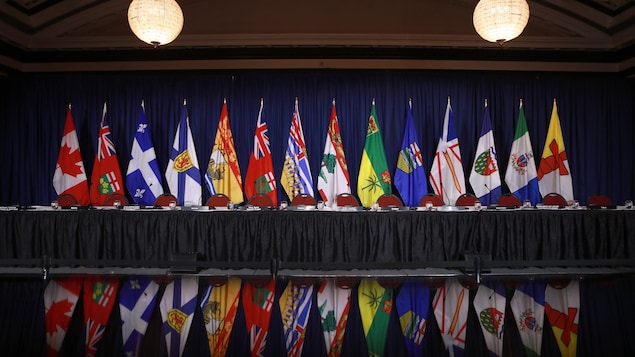Walking across provincial borders in Canada doesn’t require a passport, but shipping goods across those same boundaries often feels like an international expedition.
The Canadian Free Trade Agreement (CFTA) celebrated its seventh anniversary this April, yet businesses across the country continue navigating a complex web of regulatory differences that cost our economy billions annually. Despite promises of a unified internal market, many Canadian entrepreneurs still find themselves tangled in red tape when trying to expand nationwide.
Trevor Tombe, an economics professor at the University of Calgary who’s extensively researched this issue, estimates that eliminating these barriers could boost Canada’s GDP by between 3.8% and 7.9%. “That’s like adding a province the size of Manitoba to our economy,” Tombe explained during a recent policy forum at the C.D. Howe Institute.
Consider the experience of Alberta-based craft brewery owner Sarah McConnell, who wanted to sell her award-winning IPA in neighboring British Columbia. “I basically needed to create a parallel business structure just to navigate the different liquor regulations,” she told me. “The paperwork alone took months, and the extra costs nearly made the whole venture unprofitable.”
The barriers take numerous forms. Professional certification requirements differ across provinces, creating headaches for everyone from hairstylists to engineers. Agricultural products face varying inspection standards. Construction materials approved in one province might require additional testing in another. Even the size and weight regulations for trucks change at provincial boundaries, forcing transporters to reconfigure loads or use different vehicles.
But why do these barriers persist in an era of international free trade agreements?
Political scientists point to a combination of historical precedent, regional protectionism, and the constitutional division of powers. Canada’s federation was designed with significant provincial autonomy, and over time, each province developed its own regulatory frameworks. Dismantling these structures means persuading provincial governments to surrender some control—something they’re often reluctant to do.
“There’s also the uncomfortable truth that some barriers exist precisely because they benefit certain local industries or workers,” explains Martha Hall Findlay, president of the Canada West Foundation. “Politicians face pressure from these constituents to maintain the status quo.”
The impacts extend beyond business frustration. A 2019 IMF study found internal trade barriers particularly harmful to smaller provinces, where businesses have more limited local markets and greater need to sell across provincial lines. For consumers, the barriers translate to higher prices and less choice.
Recent progress offers some hope. The Regulatory Reconciliation and Cooperation Table established under the CFTA has tackled specific irritants like differing occupational health and safety requirements. British Columbia and Alberta signed the New West Partnership Trade Agreement, later joined by Saskatchewan and Manitoba, to reduce barriers within western Canada.
The pandemic unexpectedly accelerated some reforms. When personal protective equipment shortages threatened healthcare systems, provinces quickly harmonized standards to facilitate interprovincial movement of essential supplies. Remote work also highlighted the absurdity of certain professional licensing barriers.
Yet comprehensive reform remains elusive. The Senate Banking, Trade and Commerce Committee recently heard testimony from business leaders describing persistent challenges despite years of government promises.
“What we need is a fundamental shift in approach,” argues Perrin Beatty, president of the Canadian Chamber of Commerce. “Rather than negotiating which barriers to remove, we should establish the principle that all goods and services that meet standards in one province are automatically accepted everywhere else.”
This approach—mutual recognition—has proven successful in Australia and the European Union. But it requires political will that seems lacking in Canada’s federation.
The federal government possesses constitutional tools to force the issue. Section 121 of the Constitution Act prohibits barriers to interprovincial trade, while the “trade and commerce” power under Section 91 gives Ottawa authority to regulate economic activity crossing provincial boundaries. However, successive federal governments have preferred negotiation to confrontation, wary of provincial backlash.
Meanwhile, businesses adapt and consumers pay the price. Ontario’s beer drinkers can’t easily access Quebec’s selection, Manitoba contractors struggle to work in Saskatchewan, and Atlantic seafood processors face hurdles selling to central Canada.
For Indigenous entrepreneurs like Jennifer Harper, founder of Cheekbone Beauty in Ontario, the regulatory maze creates additional barriers atop existing challenges. “I’m trying to build a national brand while navigating different provincial cosmetic regulations. For a small business, these compliance costs eat into resources that could go toward growth and job creation.”
Digital services offer one bright spot. Software companies and online service providers generally face fewer interprovincial barriers, potentially explaining the sector’s rapid growth in Canada’s economy.
Economic research consistently shows that removing these barriers would boost productivity, wages, and innovation across Canada. As global competition intensifies and economic uncertainty grows, the luxury of maintaining inefficient internal barriers seems increasingly unaffordable.
“In the end, this isn’t about abstract economic theory,” concludes Dan Kelly, president of the Canadian Federation of Independent Business. “It’s about real businesses struggling to grow, workers unable to use their skills where needed, and consumers paying more than necessary.”
As Canada approaches its 157th birthday, the promise of a truly united economic space remains unfulfilled. The question isn’t whether interprovincial trade barriers harm our prosperity—the evidence is clear they do. The real question is whether our political leaders will finally summon the courage to dismantle them.






